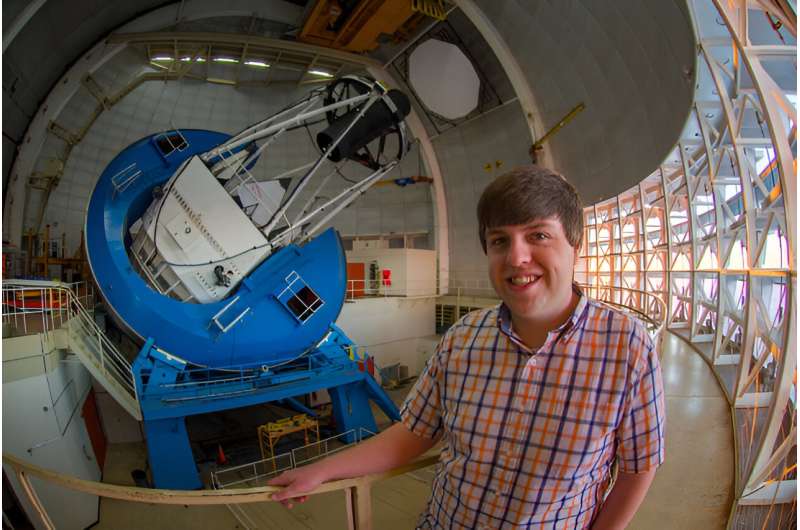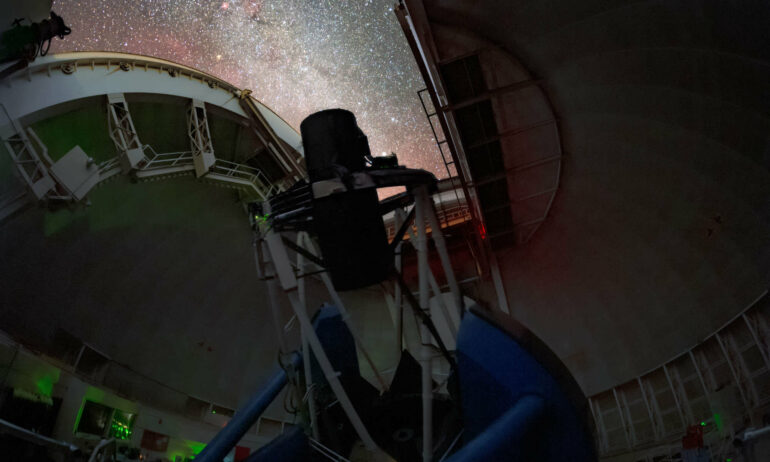Scientists have analyzed the first batch of data from the Dark Energy Spectroscopic Instrument’s quest to map the universe and unravel the mysteries of dark energy.
With 5,000 tiny robots in a mountaintop telescope, the Dark Energy Spectroscopic Instrument (DESI) allows researchers to gaze 11 billion years into the past. The light from far-flung objects in space is just now reaching DESI, enabling scientists to map the cosmos as it was in its youth while also tracing its growth. Understanding how the universe has evolved is tied to one of the biggest mysteries in physics: dark energy, which researchers hypothesize is driving the universe’s expansion.
DESI is an international science collaboration involving more than 800 scientists from around the globe. Among them are researchers from the University of Rochester’s cosmology group, an interdisciplinary group that includes professors, postdoctoral research associates, graduate students, and undergraduates from physics, astronomy, data science, and computer science. The group is co-led by Regina Demina, a professor of physics; Segev BenZvi, an associate professor of physics; and Kelly Douglass, an assistant professor of physics and astronomy (instructional).
DESI is currently in the midst of a five-year quest to measure 40 million galaxies and quasars and create the largest 3D map of the cosmos ever constructed, with the most precise measurements to date. The instrument began its survey in 2021, and researchers recently announced their analysis of the first year of collected data, including measurements of the expansion rate and composition of the universe. They published their analysis in multiple papers on the arXiv preprint server.
“The DESI data is an enormous increase in size over anything that we’ve collected before,” Douglass says. “DESI’s year-one sample of galaxies and quasars is already six times larger than the combined measurements of all previous spectroscopic surveys conducted over the last 40 years.”
And the year-one data is just the beginning, Demina adds, “The full dataset will enable us to take a closer look at the very dawn of our universe—a period when the universe went through a rapid exponential expansion.”
Optical eyes on the skies
The DESI instrument resides at the retrofitted Mayall Telescope at the National Science Foundation’s Kitt Peak National Observatory near Tucson, Arizona. The instrument incorporates optics that increase the field of view of the telescope and includes 5,000 robotically controlled optical fibers to gather spectroscopic data from objects in the telescope’s field of view and survey the three-dimensional positions of galaxies and quasars in the universe.

University of Rochester PhD student Zack Brown completed a shift at Kitt Peak National Observatory in Arizona in October 2023. The DESI instrument—the cylindrical black apparatus—is mounted on the retrofitted Mayall Telescope at Kitt Peak. © Ann Elliott, Ohio State University
The Rochester group has been part of DESI since 2017. Group members played key roles in commissioning and operating the instrument, including developing and troubleshooting software to ensure the 5,000 fibers are optimally pointed at their targets.
Rochester group members also significantly contributed to validating the year-one data, including studying systematic uncertainties—potential errors or variations—that could affect the measurements, to better ensure the accuracy and reliability of the findings.
Decoding the universe’s expansion—and dark energy
DESI is built to measure baryon acoustic oscillations (BAO)—huge bubble-like structures that galaxies follow, formed by conditions shortly after the Big Bang. In its first year, DESI used 5.7 million galaxies and quasars from its spectroscopic sample to measure the size of the BAO and estimate how fast the universe is expanding, a quantity known as Hubble’s Constant.
The BAO are also used to constrain the densities of dark matter and dark energy. Scientists long believed the universe was expanding at a constant rate, but in 1999 the expansion rate was found to be accelerating. Dark energy is hypothesized to be driving the acceleration.
Some theories suggest that one or more scalar fields (invisible forces that expand the universe), similar to the scalar field hypothesized to drive the inflationary growth of the universe shortly after the Big Bang, contribute to dark energy.
“So far, only one scalar field is known to humankind—the Higgs field,” says Demina, who was part of the team that discovered the Higgs field in 2012 using the Large Hadron Collider at CERN in Switzerland. “Now is the time to check if there are more such fields.”
Another question DESI seeks to answer is whether dark energy has a constant value everywhere in the universe—known as a cosmological constant—or if its properties differ in time and space. While DESI’s year-one BAO measurements are compatible with a cosmological constant, they slightly favor a model that suggests dark energy is an evolving or “dynamical” field.
According to BenZvi, “The evidence in favor of evolving dark energy could be very interesting, but it could also be a chance fluctuation. We can’t be sure until we look at the next batch of data. The current estimate is late 2025 for the next release.”
More information:
DESI papers: data.desi.lbl.gov/doc/papers/
Provided by
University of Rochester
Citation:
DESI first-year data delivers unprecedented measurements of expanding universe (2024, April 6)


